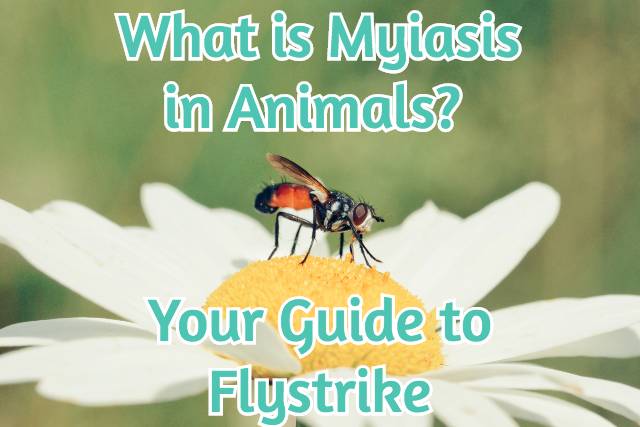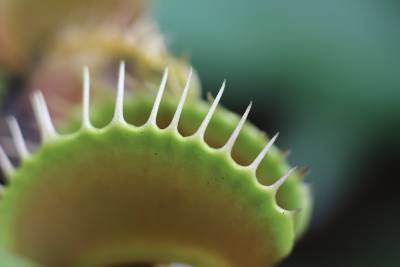
Myiasis in animals, also known as Flystrike, Blow Fly Strike, Maggot Disease/Infestation are all variations of the name given to an infestation of fly larvae in the surface tissue of the skin.
Myiasis (Flystrike) in animals is a horrible disease and can occur in any mammal, including humans, but especially in vertebrate animals where unsanitary health conditions prevail or in the elderly or infirm.
Any animal which has dirty hindquarters or a possible open wound will more than likely attract an attack by flies.

Long-haired animals are more prone to attack, as faecal matter and the strong smell of urine sticks to the hair around the anus for a prolonged period and thus, attracts the flies.
Myiasis in farm animals (sheep, cows, etc.) is always a risk. Australian farmers even use the controversial technique of removing the skin around a sheep’s anus (mulesing) to prevent infestation of maggots as they cannot grow in the resulting scar tissue. However, this has extensive criticism.
Domestic animals – dogs, cats, rabbits, any hairy mammal may also fall victim to this disgusting illness.
Myiasis originates from the Greek word for “fly” (myia). “Asis” emanates from “a diseased condition” so we have “fly disease”.

Types of Myiasis
- Nasal – blockage of nasal passages
- Aural – itchiness, smelly, wriggling feeling in the ears
- Buccal/Sinus – mouth
- Cutaneous – ulcers or sores on the skin
- Ophthalmic – eye irritation
- Anal/Vaginal.
All of these will cause extreme pain and discomfort to any animal. Edemas are common. A vet must be consulted at once to prevent a possible fatality. In the case of an infestation in the ears (aural), if the larvae have managed to reach the middle ear, they can quickly attack the brain, and this will be just awful.
Such a horrible, horrible disease.

Causes
Flies are attracted to:
- Faecal matter – dirty bums
- Urine – wet and smelly fur/hair/wool etc
- Open wounds
- Unhygienic and unsanitary conditions
- Flies are just drawn to animals in general!
There are Myiatic flies, and then there are non-Myiatic flies.
Myiatic flies take on the form of the screwfly, the botfly or the blowfly. Myiatic flies prefer wet, smelly places.
Non-myiatic flies such as the horsefly or the common housefly will carry the parasitic larva. They are vectors (carriers) of many types of disease, and they will transfer infection between one animal and another one.
Rabbits and other smaller animals are most likely to catch the disease from the botfly which lays its eggs buried in the earth. Whereas maggots emerging from other flies can be numerous, there may be only one or a few maggots appearing from the botfly.

Whenever there is a rise in temperatures, typically late spring through to fall, flies come out to play (skin crawls!). Many countries around the world have significant fly problems, but luckily in the northern hemisphere, most of the time, we have them “under control”. However, where there is one fly, there is generally another (few!) so practising good hygiene toward our animals is essential for maintaining their health. The issue is worse in countries with wet, humid climates.
From a female fly’s point of view, she will be looking for a place to lay her eggs or larvae in a place where she can be sure there is plenty of nutrients for her “babies” to feed on. She will, therefore, look for areas with faecal material, smelly urine or open wounds where she will lay her eggs.
RELATED READING: Keeping Pets Cool in Summer
Maggot infestations are not unheard of in clean animals either, so its good to be aware of the risks. If an animal is ill or elderly, they might not be able to maintain their hygiene enough to prevent an attack. In the case of pets, it’s the responsibility of the owners to check for and keep their animals clean and safe.
Symptoms
Note for those who might be a little squeamish: below there is a photo to which I have added two overlays in order to disguise what it is without losing all idea of what the photo is. You can find the true photo available on Wikimedia.org.
- The evident sign of white eggs which will hatch maggots
- Terrible smell
- Lethargy
- Skin lesions or anything untoward appearing
- Scratching and licking
- Restlessness.
This list is not exhaustive, and the most apparent sign is open and broken skin covered with wriggling maggots. You may have to delve through depths of fur in some cases, but needs must!
The larvae release an enzyme (a poison) which kills the surrounding skin tissue so there will also be an overpowering, potent smell. You’ll probably notice this before you see the infestation, especially if there is a lot of hair.

Treatment
This disease cannot be treated without the aid of a vet. Once you suspect your pet/animal has this disease, you have to get to the vet because it can be fatal within 24 hours so this is a life-threatening issue.
Once the maggots are removed, the skin is cleaned with antiseptic. Any dead skin is removed. The surrounding fur will also be taken care of so to avoid bacteria and other infections.
Once clean, the wound(s) is covered with a bandage. Antibiotics will be prescribed, by mouth or in spray form – sometimes both depending on the gravity of the situation.
In severe cases, more than one visit to the vet will be required.
How can I prevent Flystrike?

Proper hygiene has to be the top priority for the prevention of myiasis in animals. Check for, treat, cover and clean wounds regularly. If you find maggots, take your pet to the vet immediately. As mentioned earlier, the grubs contain a poison which could send your beloved into toxic shock, and this can be deadly.
Commit to cleaning rabbit hutches out daily and keep rabbits inside during the summer.
- Hang fly traps like sticky paper
- Place Venus Fly Trap plants about the place
- Blue lights which attract the flies
- Fly netting/blinds in/over doorways
- Proper grooming every day
- Check the cleanliness of your pet’s rear after every toilet. Clean as well as dry.

It’s known that some free-range poultry help in reducing the number of flies hanging around but only in small numbers. You could start keeping chickens or ducks if you have a pond. You don’t want too many because their faeces could begin to attract the flies, but a few might help as they will relish gobbling up these insects.
As for human infection, when travelling in hot, humid countries, use lots of repellents, long sleeves, long trousers, mosquito nets, anything logical, sensible and safe to avoid being bitten. Remember the typical hat in Australia with the corks hanging from it.
What is Myiasis in Animals? Your Guide to Flystrike
I hope not but has your pet experienced this infection? Do you have any other preventative tips to avoid flies near you or your family? Please let us know in the comments below so we can share.
Thank you for reading, your likes and your comments. Please share with your friends and family.





Hi Susie,
Thanks for warning everybody about the risks of myiasis.
It’s good to know that we have 24 hours to act if we suspect that something is amiss.
Thank you.
Thank you Michael. Yes, it´s a very small window of time for action and every so important.
Ahhh, poor animals. There are several dogs in the neighborhood that are on their own all the time, guarding the orchards. I don’t think the owners will ever check for this disease. They hardly ever come to check if the poor animals are still alive.
I wonder if that is the reason they bark and howl so much at night.
I can’t have pets because of my allergy for hairs, but still, this is one the aspects I hate over here in Spain – the way they treat their animals is in some cases horrific.
Thanks for your explanation, because now I might be more forgiving when they bark me awake at night. 🙂
Hi Hannie. Ah yes, if you´re allergic, it can be difficult to have pets although there are animals which are hypoallergenic (non-allergic) including dogs and cats. The poor dogs living around you sound like they are not treated well at all, poor things. And yes, they could well be ill if they are making lots of noise, trying to get some attention. Sounds like they need a vet to check them over and also good “forever homes”! Do the owners provide food, water and shelter/shade? Thank you for your comments, Hannie. Hope you might get some sleep!